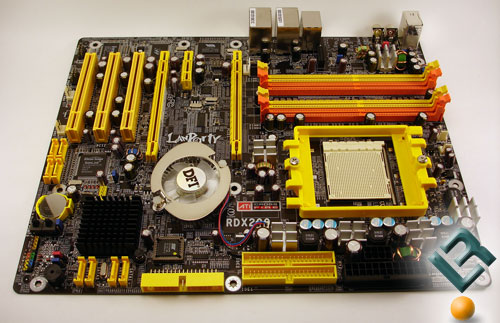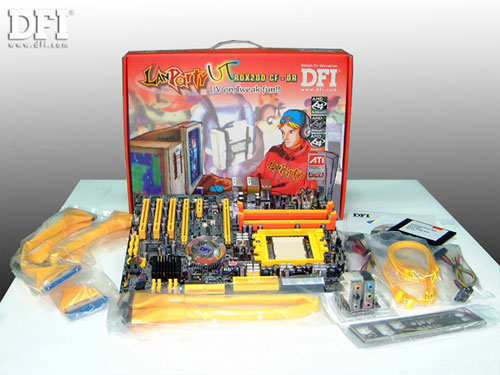Introduction

Almost a year ago, DFI introduced their LANParty NF4 motherboards. While all proved extremely popular (mainly for their incredible performance and sweet bundle), the SLI versions were the apple of DFI’s eye. Enthusiasts loved the incredible performance that resulted from NVidia’s NF4 chipset as well as the ability to pair up two like cards and significantly improve the graphics performance of their system.
Over the past year the DFI NF4 motherboards have arguably become the most popular boards on the market. Not only has DFI developed one of the largest support forums around, they also have numerous threads spread across enthusiast sites dedicated to their boards. Then there are the BIOS’, where it seems a new one comes out about one a day or so.
While NVidia and its NF4 chipset have had more than a year to entrench itself as the chipset of choice for just about everyone, can the ATI Radeon Express200 chipset cut into NVidia’s market domination? Another feature of the RDX200 CF-DR is ATI’s long awaited dual graphics solution, “Crossifire”. Though Crossfire won’t be the focus of this article, keep an eye out as very soon we’ll be covering ATI’s newest graphics solution.
Today, Legit Reviews takes a look at DFI’s RDX200 CF-DR. Did DFI bite off more than they could chew? Did waiting almost an entire year to release their graphics solution help ATI learn from NVidia’s successes and failures? And, most importantly (at least to me, today) does the RDX200 CF-DR live up to the reputation DFI has developed with their LANParty boards?
Let’s look over the specs, and move on to the layout and some testing.

| CPU |
- AMD Athlon 64 X2 / Athlon 64 FX / Athlon 64 / Sempron
- Socket 939
|
| Chipset |
- ATI chipset
– Northbridge: ATI Radeon Xpress 200 CrossFire
– Southbridge: ATI SB450
|
| Front Side Bus |
- 2000MT/s HyperTransport interface
|
| Memory |
- Four 184-pin DDR SDRAM DIMM sockets
- Supports dual channel (128-bit wide) memory interface
- Supports up to 4GB system memory
- Supports PC2100 (DDR266), PC2700 (DDR333) and PC3200 (DDR400) DDR SDRAM DIMM
|
| BIOS |
- Award BIOS
- CMOS Reloaded
- CPU/DRAM overclocking
- CPU/DRAM/Chipset overvoltage
- 4Mbit flash memory
|
| Power Management |
- Supports ACPI STR (Suspend to RAM) function
- Wake-On-Events include:
– Wake-On-PS/2 Keyboard/Mouse
– Wake-On-USB Keyboard/Mouse
– Wake-On-Ring
– Wake-On-LAN
– RTC timer to power-on the system
- AC power failure recovery
|
| Hardware Monitor |
- Monitors CPU/system/chipset temperature
- Monitors 12V/5V/3.3V/Vcore/Vbat/5Vsb/Vchipset/Vdram voltages
- Monitors the speed of the CPU fan, Fan 2 and Fan 3 fan
- CPU Overheat Protection function monitors CPU temperature during system boot-up
|
| Audio |
- Karajan audio module
– Realtek ALC882 8-channel High Definition Audio CODEC
– 6 audio jacks
– 1 CD-in connector
– 1 front audio connector
- True stereo line level outputs
- S/PDIF-in/out interface
|
| LAN |
- Dual Gigabit LAN – Marvell 88E8053 PCI Express and Marvell 88E8001 PCI LAN
- Fully compliant to IEEE 802.3 (10BASE-T), 802.3u (100BASE-TX) and
802.3ab (1000BASE-T) standards
|
| IDE |
- Supports two IDE connectors that allow connecting up to four UltraDMA 133Mbps
hard drives
|
| Serial ATA with RAID |
- Four Serial ATA ports supported by the ATI SB450 chip
– SATA speed up to 1.5Gb/s
– RAID 0 and RAID 1
- Four Serial ATA ports supported by the Silicon Image Sil 3114 chip
– SATA speed up to 1.5Gb/s
– RAID 0, RAID 1, RAID 0+1 and RAID 5
|
| IEEE 1394 |
- VIA VT6307
- Supports two 100/200/400 Mb/sec ports
|
| Rear Panel I/O Ports |
- 1 mini-DIN-6 PS/2 mouse port
- 1 mini-DIN-6 PS/2 keyboard port
- 2 S/PDIF RCA jacks (S/PDIF-in and S/PDIF-out)
- Karajan audio module (6 audio jacks)
- 1 IEEE 1394 port
- 2 RJ45 LAN ports
- 6 USB 2.0/1.1 ports
|
| I/O Connectors |
- 1 connector for 2 additional external USB 2.0/1.1 ports
- 1 connector for 1 external IEEE 1394 port
- 1 connector for 1 external serial port
- 1 connector for the Karajan audio module
- 1 front audio connector for external line-out and mic-in jacks (on the Karajan audio module)
- 1 CD-in internal audio connector (on the Karajan audio module).
- 1 S/PDIF connector for optical cable connection
- 1 IrDA connector
- 1 CIR connector
- 8 Serial ATA connectors
- 2 IDE connectors
- 1 floppy connector
- 1 24-pin ATX power connector
- 1 8-pin ATX 12V power connector
- 1 4-pin 5V/12V power connector (FDD-type)
- 1 front panel connector
- 5 fan connectors
- 4 diagnostic LEDs
- EZ touch switches (power switch and reset switch)
|
| Expansion Slots |
- 2 PCI Express x16 slots CrossFire mode – Each x16 slot operates at x8 bandwidth. Single VGA mode – PCIE1 slot operates at x16 bandwidth. PCIE3 slot operates at x1 bandwidth.
- 1 PCI Express x1 slot
- 3 PCI slots
|
| PCB |
- ATX form factor
- 24cm (9.45″) x 30.5cm (12″)
|
Now that we know what the basic features of the board are we can take a look at the layout of the motherboard.



Comments are closed.